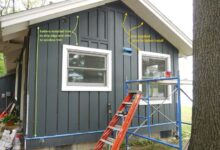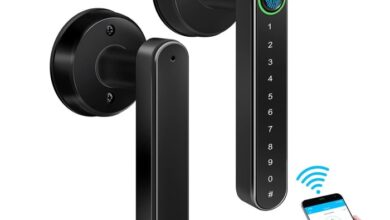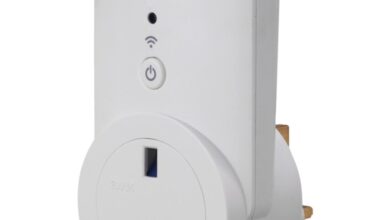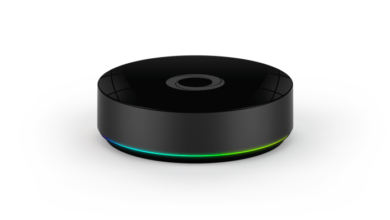Home Security Automation Smarter, Safer Homes
Home Security Automation is revolutionizing how we protect our homes. Forget clunky alarm systems and unreliable manual processes; today’s technology offers seamless integration, proactive threat detection, and unparalleled convenience. This isn’t just about alarms; it’s about creating a truly intelligent and responsive security ecosystem that adapts to your lifestyle, anticipating potential threats and providing peace of mind, all from the palm of your hand.
We’ll explore the core components, benefits, and potential pitfalls of this rapidly evolving field, helping you determine if home security automation is the right choice for you.
From smart locks that unlock with your phone to cameras that send alerts of unusual activity, the possibilities are endless. We’ll delve into various system types, installation processes, integration with other smart home devices, and address crucial security and privacy concerns. By the end, you’ll have a comprehensive understanding of how to leverage technology to build a safer, more efficient, and more connected home.
Defining Home Security Automation
Home security automation represents a significant leap forward in protecting our homes and loved ones. It’s more than just installing a few security cameras; it’s about creating a comprehensive, interconnected system that proactively identifies and responds to potential threats, offering peace of mind and enhanced safety. This system leverages technology to automate security tasks, providing a level of protection far exceeding traditional methods.
The result is a more secure and convenient living environment.Home security automation systems are built upon several core components working in concert. These components interact seamlessly to provide a robust and effective security solution. The effective integration of these elements is crucial for optimal performance and reliability.
Core Components of Home Security Automation Systems
A typical home security automation system consists of several key elements. These include sensors, control panels, smart locks, cameras, and automation software. Sensors detect intrusions or other events, triggering alerts or automated responses. The control panel acts as the central hub, managing all components and communicating with users. Smart locks allow for remote access and keyless entry, while cameras provide visual monitoring and recording capabilities.
Sophisticated automation software ties everything together, enabling custom rules and scenarios to be implemented. The reliability of the entire system is highly dependent on the quality and integration of each component.
Technologies Used in Home Security Automation
A variety of technologies are employed in modern home security automation systems, each playing a vital role in the overall functionality and effectiveness. These technologies, constantly evolving, provide increasingly sophisticated levels of protection and convenience.
- Sensors: Motion detectors, door/window sensors, glass break detectors, and even vibration sensors are used to detect unauthorized entry or other unusual activity. These sensors often utilize infrared, ultrasonic, or magnetic technologies to function reliably.
- Smart Locks: These locks offer keyless entry via keypad, smartphone app, or other methods, eliminating the need for traditional keys and enhancing security by allowing for remote locking/unlocking. They often integrate with the broader home automation system, allowing for automated locking at night or unlocking upon arrival.
- Cameras: IP cameras, security cameras with night vision, and even doorbell cameras provide visual surveillance, often with features like motion detection, recording capabilities, and remote viewing via smartphone apps. High-resolution cameras with advanced features like facial recognition are becoming increasingly common.
- Automation Software: This is the “brains” of the operation, integrating all components and enabling automation rules. Software platforms allow users to customize their security system to fit their specific needs and preferences, creating tailored security scenarios based on time of day, user location, or other triggers. The software often provides remote monitoring and control capabilities through smartphone apps.
Examples of Home Security Automation Scenarios
The true power of home security automation lies in its ability to automate responses to detected events, significantly improving security and convenience. These automated responses are configurable and adaptable to the user’s needs.
- Automatic Lighting Based on Motion Detection: Motion sensors detect movement in a designated area, automatically activating lights to deter intruders and illuminate the space. This can be particularly effective in hallways, garages, or outdoor areas.
- Automated Door Locking at Night: The system automatically locks all doors at a pre-set time, ensuring the home is secure while residents are asleep. This eliminates the need for manual locking and reduces the risk of forgetting to lock up.
- Automated Security System Arming/Disarming: Based on the user’s location (determined via GPS or geofencing), the system automatically arms or disarms itself, ensuring that the system is active only when necessary. This eliminates the need to manually arm and disarm the system.
- Smart Home Integration: Many systems integrate with other smart home devices, enabling automated responses such as turning on lights or activating sirens upon detection of an intrusion. This creates a comprehensive and interconnected smart home security ecosystem.
Benefits and Drawbacks of Home Security Automation
Home security automation offers a compelling blend of enhanced protection and streamlined convenience, transforming how we safeguard our homes. However, like any technological advancement, it comes with its own set of considerations, including cost, complexity, and potential vulnerabilities. Understanding both the advantages and disadvantages is crucial before embracing this evolving security landscape.
The benefits of automated home security are undeniable. Imagine a system that instantly alerts you to any intrusion, regardless of your location. This proactive approach, coupled with features like smart locks and automated lighting, significantly deters potential criminals and provides peace of mind. Beyond security, automation adds a layer of convenience, allowing you to manage your home’s security from anywhere, anytime, through a user-friendly app.
This level of control is a significant upgrade from traditional methods.
Enhanced Safety and Convenience Features
Automated systems offer a multifaceted approach to security. Smart locks, for instance, eliminate the need for physical keys, allowing for remote access and eliminating the risk of lost or stolen keys. Integrated security cameras provide real-time monitoring and recording capabilities, offering visual evidence in case of an incident. Motion sensors trigger alarms and lights, deterring intruders and alerting you to any unusual activity.
These features combine to create a robust security ecosystem far surpassing the capabilities of traditional systems. Consider a scenario where a homeowner is away on vacation: A smart home system can detect a broken window, instantly alert authorities, and even notify neighbors, ensuring a swift response to a potential threat. This proactive response is a significant advantage over relying solely on a traditional alarm system that only sounds after an intrusion has occurred.
Cost and Complexity Considerations
Implementing a comprehensive home security automation system can be a significant investment. The initial setup costs, encompassing the purchase of hardware and software, can be substantial. Furthermore, ongoing maintenance and potential subscription fees for cloud services can add to the overall expense. The technological complexity can also be a barrier for some users. Setting up and managing the system may require a certain level of technical proficiency, or the hiring of a professional installer, further adding to the cost.
This contrasts sharply with traditional systems which often involve a simpler, one-time installation cost. For example, a basic alarm system may cost a few hundred dollars to install, while a fully automated smart home security setup could easily exceed several thousand, depending on the features and scale of the system.
Vulnerabilities and Potential Risks
While home security automation offers numerous advantages, it’s essential to acknowledge potential vulnerabilities. The reliance on internet connectivity makes the system susceptible to hacking or cyberattacks. A compromised system could lead to unauthorized access to your home and personal data. Furthermore, system malfunctions or power outages could render the security system ineffective, leaving your home vulnerable. It is crucial to choose reputable vendors and implement robust security measures, such as strong passwords and two-factor authentication, to mitigate these risks.
A real-world example illustrates this point: News reports frequently highlight instances of smart home devices being hacked, resulting in unauthorized access and privacy breaches. This underscores the importance of selecting secure and well-maintained systems.
Comparison with Traditional Security Methods
Traditional security methods, such as basic alarm systems and physical locks, offer a level of protection but lack the sophistication and convenience of automated systems. While cost-effective in the short term, they are often reactive rather than proactive. Automated systems, conversely, provide real-time monitoring, remote control, and advanced features like smart locks and integrated cameras, offering a significantly enhanced level of security and convenience.
The trade-off lies in the higher initial investment and potential complexity of automated systems compared to the simpler, less expensive traditional alternatives. The choice between these approaches depends on individual needs, budget, and technical comfort levels.
Types of Home Security Automation Systems
Choosing the right home security system can feel overwhelming, given the variety of options available. Understanding the key differences between system types is crucial for making an informed decision that best suits your needs and budget. This section breaks down the main categories of home security automation, highlighting their features, pros, and cons to help you navigate the market effectively.
We’ll examine different approaches to home security, from DIY solutions to professionally monitored systems, considering factors like cost, ease of installation, and overall security levels.
Home security automation systems fall into several key categories, each with its own set of strengths and weaknesses. The optimal choice depends heavily on your technical skills, budget, and desired level of security. Factors such as the size of your home, the number of entry points, and your personal comfort level with technology will also influence your decision.
DIY Home Security Systems
DIY (Do-It-Yourself) systems are designed for users who prefer to install and manage their security systems independently. These systems typically offer a wide range of features at a lower initial cost compared to professionally installed options. However, they may require more technical expertise and may lack the professional monitoring and support services offered by professionally installed systems. Examples include SimpliSafe and Ring Alarm, which offer various sensors, cameras, and control panels that can be easily installed by homeowners.
Professionally Installed Home Security Systems
Professionally installed systems offer a higher level of security and often include professional monitoring services. A trained technician installs the system, ensuring proper placement and functionality of all components. These systems usually incorporate advanced features like 24/7 monitoring, cellular backup, and integration with other smart home devices. While the upfront cost is typically higher, the peace of mind and comprehensive security features often outweigh the added expense.
Companies like ADT and Vivint are well-known providers of professionally installed and monitored systems.
Wireless vs. Wired Systems
The choice between wireless and wired systems often hinges on installation convenience and security concerns. Wireless systems, utilizing technologies like Wi-Fi and Z-Wave, offer easy installation and flexibility in placement of sensors and cameras. However, they are potentially vulnerable to signal interference or hacking. Wired systems, using physical cabling, provide a more secure and reliable connection, but require professional installation and are less flexible in terms of component placement.
Many modern systems offer a hybrid approach, combining wireless and wired components to leverage the advantages of both.
| System Type | Cost | Features | Ease of Installation | Level of Security |
|---|---|---|---|---|
| DIY Wireless (e.g., SimpliSafe) | Low to Moderate | Sensors, cameras, motion detectors, smartphone control | Easy | Moderate |
| DIY Wired (less common) | Moderate | Similar to wireless, but with wired connections for enhanced reliability | Difficult (professional help often recommended) | High |
| Professionally Installed Wireless (e.g., ADT) | Moderate to High | Comprehensive features, professional monitoring, cellular backup | Easy (professional installation) | High |
| Professionally Installed Wired (less common) | High | Most comprehensive features, highest level of reliability, professional monitoring | Difficult (professional installation required) | Very High |
Examples of Popular Brands and Their Offerings
Several prominent brands offer a range of home security automation systems. For instance, Ring offers a robust DIY ecosystem centered around video doorbells and security cameras, seamlessly integrating with other smart home devices. Conversely, ADT provides comprehensive professionally installed and monitored systems with a wide array of features and dedicated customer support. Other notable players include Vivint, which emphasizes smart home integration, and SimpliSafe, known for its user-friendly DIY approach.
The choice ultimately depends on individual needs and preferences. Consider factors like desired features, budget constraints, and technical proficiency when selecting a system.
Setting up and Maintaining a Home Security Automation System
Setting up a home security automation system can seem daunting, but with a methodical approach, it’s a manageable project offering significant rewards in peace of mind and potential cost savings. This guide breaks down the process into manageable steps, covering everything from initial planning to ongoing maintenance, ensuring a smooth and effective implementation. Remember, the level of complexity will depend on your chosen system and the size of your home.
A well-designed home security system provides a layered approach to protection, combining physical barriers with smart technology. This integration allows for proactive monitoring and immediate response to potential threats, increasing the overall security of your home significantly. Think of it as building a robust network, where each component works in harmony to provide comprehensive protection.
System Component Selection and Installation
Choosing the right components is crucial for a successful installation. Consider factors like your budget, home size, and desired level of automation. A basic system might include a central control hub (often a smart home hub like Amazon Alexa or Google Home), door/window sensors, a motion detector, and security cameras. More advanced systems might incorporate smart locks, lighting controls, and even environmental sensors.
Installation typically involves connecting these devices to your home’s Wi-Fi network and configuring them through the system’s app or software. For example, a door sensor involves attaching two parts—one to the door frame and one to the door—and pairing them with the hub. Motion detectors usually plug into a power outlet and need to be strategically positioned to cover key areas.
Cameras require a power source and a clear view of the areas you wish to monitor. Always follow the manufacturer’s instructions meticulously for each device.
Configuring and Integrating System Components, Home Security Automation
Once installed, each component needs to be configured individually and then integrated into the unified system. This often involves setting up zones (defining areas within your home monitored by specific sensors), scheduling routines (such as automatically arming the system at night), and establishing notification preferences (e.g., receiving alerts via email or smartphone app). Many systems offer customizable settings to tailor the system to your specific needs and preferences.
For example, you might set up a geofencing feature that automatically disarms the system when you arrive home and re-arms it when you leave. Integrating different components often requires using the system’s app or software to establish connections and communication pathways between them. This may involve adding devices, configuring settings, and potentially using third-party integrations.
Maintaining and Troubleshooting Your Home Security Automation System
Regular maintenance is key to ensuring the long-term effectiveness of your system. This includes checking battery levels in wireless sensors, testing the functionality of all components regularly, and updating the system’s software. Common issues might include connectivity problems (due to Wi-Fi interference or power outages), malfunctioning sensors (requiring battery replacement or recalibration), or false alarms (potentially caused by pets or environmental factors).
Troubleshooting often involves checking the system’s logs for error messages, restarting devices, and consulting the manufacturer’s support documentation or online forums for solutions. Regular software updates are crucial for patching security vulnerabilities and improving system performance. Proactive maintenance, like testing your system weekly, can prevent minor issues from escalating into major problems. For example, a simple test could involve opening a door and confirming an alert is sent to your phone.
Integration with Other Smart Home Devices
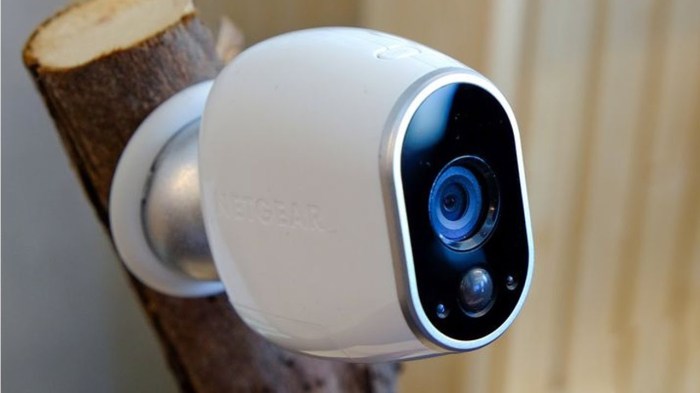
The true power of a home security automation system lies not just in its individual components, but in its seamless integration with other smart home devices. This interconnectedness creates a holistic ecosystem, enhancing both security and convenience in ways a standalone system simply cannot. By linking security measures with other aspects of your smart home, you unlock a level of control and automation previously unimaginable.Smart home integration elevates your security system beyond simple alerts.
It transforms your home into a proactive, responsive environment that anticipates and mitigates threats while simultaneously streamlining daily life. This synergy between security and convenience isn’t just a futuristic fantasy; it’s a rapidly developing reality shaping the future of home safety.
Enhanced Security Through Smart Home Integration
Integrating your security system with smart lighting, for instance, can significantly improve your home’s security posture. Imagine this: motion sensors detect movement outside your home after dark. The security system immediately triggers your smart lights, illuminating the perimeter and potentially deterring intruders. Simultaneously, the system could send you a notification, allowing you to remotely monitor the situation.
This proactive approach is far more effective than simply relying on passive security measures. Further enhancing this scenario, smart locks can be automatically locked upon detecting unauthorized entry attempts, creating multiple layers of defense.
Convenience and Automation Enhancements
The integration extends beyond reactive security measures. Consider the convenience of automatically disarming your security system when you arrive home. Geolocation features on your smartphone, coupled with smart locks, allow for keyless entry and automatic system disarm upon your arrival within a pre-defined radius of your house. Similarly, you can automate the arming of the system when you leave, ensuring your home is always protected, even when you forget to do it manually.
This level of automation reduces the likelihood of human error and increases overall security.
Energy Efficiency Improvements Through System Integration
Smart thermostats integrated with your security system can optimize energy consumption based on your presence or absence. When the security system detects that everyone has left the home, the thermostat can automatically lower the temperature, saving energy and reducing utility bills. Conversely, it can pre-heat or cool the house before your arrival, ensuring a comfortable environment without unnecessary energy waste.
This integration provides tangible cost savings while contributing to environmental sustainability. For example, a family consistently leaving their home for eight hours daily could see a significant reduction in their energy bills – potentially hundreds of dollars annually – by implementing this type of integration. Such savings can be substantial, particularly for larger households or those in regions with high energy costs.
Security and Privacy Concerns
The increasing reliance on home security automation systems introduces a new layer of complexity to home security, demanding careful consideration of potential vulnerabilities and privacy implications. While these systems offer significant benefits in enhancing safety and convenience, understanding and mitigating the associated risks is crucial for responsible usage. This section delves into the key security and privacy concerns, offering practical strategies to safeguard your home and personal information.Security risks associated with home security automation systems stem from several potential entry points.
These systems often rely on internet connectivity, making them susceptible to hacking attempts, malware infections, and unauthorized access. Furthermore, vulnerabilities in the system’s software or hardware can be exploited by malicious actors, potentially compromising the entire system and granting access to your home. Data breaches, resulting in the theft of personal information, are a significant concern.
Enhance your insight with the methods and methods of Voice-Controlled Home.
System Vulnerabilities and Hacking
Weak passwords, outdated software, and insecure network configurations represent significant security weaknesses. For example, a system using a default password or an easily guessable combination leaves the system open to unauthorized access. Similarly, failing to update the system’s software to the latest version leaves it vulnerable to known exploits that hackers can leverage. A poorly secured network connection, such as a Wi-Fi network without password protection or strong encryption, allows hackers to intercept data transmitted between the system and other devices.
Robust password policies, regular software updates, and the use of strong encryption protocols are essential countermeasures. Multi-factor authentication adds an extra layer of security, significantly reducing the risk of unauthorized access.
Data Collection and Storage
Home security automation systems collect a substantial amount of data, including video footage from security cameras, motion sensor data, and access logs. This data is often stored on cloud servers or locally on the system’s hardware. The potential misuse of this data is a serious privacy concern. Data breaches could expose sensitive information, such as your daily routines, personal belongings, and even the presence or absence of individuals within your home.
Furthermore, the potential for data misuse by the system’s manufacturer or third-party service providers adds another layer of complexity.
Data Privacy Protection Strategies
To mitigate these risks, users should prioritize data encryption both in transit and at rest. Encryption scrambles the data, making it unreadable to unauthorized individuals even if intercepted. Regularly reviewing and updating privacy settings is also crucial. Many systems offer granular control over data collection and storage preferences, allowing users to limit the amount of data collected and stored.
Choosing reputable manufacturers with strong security practices and transparent data handling policies is vital. Furthermore, users should be aware of the terms and conditions of the service, understanding how their data is collected, used, and protected. Consider using a virtual private network (VPN) to encrypt your internet traffic, providing an additional layer of security for data transmitted to and from the system.
Future Trends in Home Security Automation
The landscape of home security is undergoing a rapid transformation, driven by advancements in artificial intelligence, machine learning, and the Internet of Things (IoT). These innovations are not just enhancing existing systems; they’re fundamentally reshaping how we approach home protection, moving beyond basic intrusion detection to proactive threat assessment and personalized security solutions. The coming decade promises even more sophisticated and integrated systems, offering unprecedented levels of safety and convenience.The integration of AI and machine learning is arguably the most significant trend.
These technologies are empowering home security systems to learn user behavior patterns, differentiate between threats and benign events, and adapt to changing circumstances. This goes far beyond simple motion detection; we’re talking about systems that can identify unusual sounds, recognize faces, and even predict potential security breaches based on historical data and external factors like weather patterns. This proactive approach minimizes false alarms and maximizes the effectiveness of security measures.
AI-Powered Predictive Security
AI is moving beyond reactive responses to become a predictive force in home security. Imagine a system that analyzes your daily routines and identifies deviations, such as an unusually late arrival home, triggering a notification and potentially even contacting emergency services. This level of personalized threat assessment minimizes the risk of break-ins and other security breaches. Furthermore, AI-powered systems can learn to recognize specific threats based on past incidents, both within your home and in your neighborhood, enabling a tailored security response.
For example, if a series of burglaries have targeted homes with unsecured back doors in your area, the system might prioritize alerts related to back door activity. The system could even adjust its response based on the time of day, recognizing that a late-night noise might be less suspicious than a similar noise during the day.
Biometric Authentication Advancements
Beyond fingerprint and facial recognition, we’re seeing the emergence of more sophisticated biometric authentication methods. Voice recognition is becoming increasingly accurate and secure, allowing for hands-free access control. Similarly, advancements in gait analysis – the study of how people walk – offer a unique and potentially highly secure form of identification. These systems could detect unauthorized individuals based on subtle variations in their gait, even if they manage to bypass other security measures.
Imagine a system that not only unlocks your front door with your voice but also verifies your identity based on your unique walking pattern, adding another layer of protection against intruders. The combination of multiple biometric methods further enhances security and reduces the risk of unauthorized access.
Enhanced Sensor Technology and Integration
The proliferation of smart sensors is expanding the capabilities of home security systems exponentially. We’re seeing the development of more sensitive and sophisticated sensors that can detect a wider range of threats, including gas leaks, water damage, and even subtle signs of structural damage. These sensors can be seamlessly integrated into a comprehensive home security system, providing a holistic view of the home’s safety and security.
Moreover, the integration of these sensors with other smart home devices allows for a more proactive and responsive security system. For instance, a smart thermostat could automatically adjust the temperature in response to a detected intrusion, making the home less attractive to intruders. Similarly, smart lighting could automatically illuminate the exterior of the home upon detecting unusual activity.
This integrated approach creates a robust and dynamic security system.
Home Security in 2030: A Speculative Glimpse
In the next 5-10 years, home security systems will likely become even more integrated with our daily lives, acting as a proactive guardian rather than simply a reactive alarm system. Imagine a system that anticipates potential threats based on real-time data analysis, such as weather forecasts predicting potential power outages or social media activity indicating an increase in crime in the neighborhood.
These predictive capabilities will enable the system to proactively adjust security measures, such as reinforcing locks or increasing surveillance during periods of heightened risk. Furthermore, the use of advanced AI and machine learning will allow for more personalized security solutions, tailoring the system’s response to individual needs and preferences. The home security system of the future will be less about reacting to threats and more about preventing them altogether, creating a safer and more secure environment for homeowners.
Consider a scenario where a system anticipates a severe storm and automatically closes and secures windows and doors, simultaneously contacting emergency services in case of a power outage. This proactive approach transforms home security from a reactive measure to a proactive shield.
Cost Considerations for Home Security Automation
Investing in a home security automation system is a significant decision, impacting both your safety and your budget. Understanding the various cost factors involved is crucial for making an informed choice and avoiding unexpected expenses. This section breaks down the cost landscape, helping you navigate the financial aspects of securing your home intelligently.
DIY vs. Professional Installation Costs
The initial investment in a home security system can vary drastically depending on whether you opt for a DIY (Do It Yourself) installation or choose professional services. DIY kits typically offer lower upfront costs, ranging from a few hundred dollars to potentially over a thousand depending on the number of sensors and features included. However, this approach requires technical skills and time commitment.
Professional installation, while significantly more expensive – often starting at $1,000 and escalating based on system complexity and home size – eliminates the technical hurdles and provides peace of mind knowing the system is expertly configured and functioning optimally. For example, a basic DIY system with a few door/window sensors and a central hub might cost around $300, while a professionally installed system with multiple cameras, smart locks, and professional monitoring could easily exceed $2,000.
System Feature Costs
The features you choose directly influence the overall cost. Basic systems with limited sensors and functionality are cheaper than comprehensive packages that include features like smart locks, video surveillance, environmental monitoring (temperature, smoke detection), and advanced automation capabilities. Adding each feature incrementally increases the total cost, whether purchasing individual components or opting for a bundled package. For instance, a simple motion sensor might cost $20-$50, while a high-resolution outdoor security camera could cost several hundred dollars.
Integrating smart locks adds another layer of expense, ranging from $100 to $300 per lock, depending on the brand and features.
Factors Influencing Overall Cost
Several factors can significantly impact the final cost of your home security automation system.
- System Size and Complexity: Larger homes with more entry points and rooms require more sensors and equipment, increasing costs.
- Professional Monitoring Fees: While not an initial cost, monthly fees for professional monitoring services add ongoing expenses. These fees vary based on the level of service and the monitoring company.
- Equipment Upgrades and Replacements: Technology evolves rapidly; budgeting for future equipment upgrades or replacements is essential for maintaining system functionality and security.
- Hidden Costs: Unexpected expenses like wiring upgrades, additional labor for complex installations, or specialized equipment for unique home setups can impact the budget.
- Subscription Services: Some systems require ongoing subscription fees for cloud storage, advanced features, or app access. These recurring costs should be factored into the long-term budget.
Strategies for Managing Costs Effectively
Effective cost management requires careful planning and consideration.
- Prioritize Essential Features: Focus on core security features like door/window sensors and motion detectors before adding more advanced capabilities. This allows for a phased approach to system implementation.
- Compare Prices and Packages: Research various brands and compare pricing across different packages to identify the best value for your needs.
- Explore DIY Options Strategically: If you’re technically inclined, a DIY approach can save money, but carefully assess your skills and time commitment before proceeding.
- Bundle Services: Some providers offer bundled packages combining security systems with other smart home services, potentially leading to cost savings.
- Consider Financing Options: Some companies offer financing plans to spread the cost of the system over time, making it more manageable.
Illustrative Examples of Home Security Automation in Action
Real-world applications of home security automation systems highlight their effectiveness in protecting homes and enhancing safety. These systems go beyond simple alarms, offering proactive responses and sophisticated notification methods. The following scenarios demonstrate the power and versatility of this technology.
Intrusion Detection Scenario: Unwanted Entry at Night
Imagine a family asleep at home. At 2:00 AM, a motion sensor in the living room detects movement. This triggers the system’s immediate response. The security system’s central hub instantly activates the interior lights, creating a sudden burst of illumination to deter the intruder. Simultaneously, a high-pitched siren is activated, and the system sends push notifications to the homeowner’s smartphones, displaying a live video feed from the security camera positioned in the living room.
The notification also includes the location of the intrusion. The homeowner, alerted by the notification, can remotely contact the authorities or view the live feed to assess the situation, demonstrating a high level of automation and immediate user response. The user experience is one of immediate awareness and control, minimizing response time and maximizing security.
Fire Detection Scenario: Kitchen Fire
A cooking fire starts in the kitchen. A smoke detector, integrated into the home security system, senses the smoke and triggers an immediate alarm. The system automatically initiates a pre-programmed emergency response sequence. This includes activating the kitchen’s fire suppression system (if installed), turning off the gas supply to the stove, and sending alerts to the homeowner’s phones and pre-designated emergency contacts.
The notification includes the location of the fire and a live video feed from a camera near the kitchen. The user experience involves receiving rapid, precise information about the emergency, allowing for quick action or emergency service dispatch. This scenario showcases the life-saving potential of automated fire detection and response. The level of automation is high, prioritizing immediate action over user intervention.
Unexpected Power Outage Scenario: Storm-Related Power Failure
A severe thunderstorm causes a power outage. The home security system, equipped with a backup battery, continues to function. The system immediately sends a notification to the homeowner’s phone, indicating the power outage and confirming the system’s continued operation. Simultaneously, battery-powered security cameras remain active, providing ongoing surveillance. The system also automatically sends a message to a pre-programmed list of emergency contacts to inform them of the outage and ensure safety.
This proactive communication minimizes anxiety and facilitates coordinated response in case of further emergencies. The user experience is one of reassurance and maintained situational awareness even during a disruption in power. This illustrates the system’s resilience and ability to provide continued security and communication despite unforeseen circumstances. The automation involved is primarily in the continued operation and notification, maintaining a crucial level of security during a power failure.
Last Word
Ultimately, Home Security Automation represents a significant leap forward in residential safety and convenience. While cost and complexity are factors to consider, the benefits of enhanced security, proactive threat detection, and seamless integration with other smart home devices far outweigh the drawbacks for many homeowners. By understanding the technology, addressing potential vulnerabilities, and choosing a system that aligns with your needs and budget, you can transform your home into a secure and intelligent haven.
Embrace the future of home security—it’s smarter, safer, and more connected than ever before.



